
The world of fashion is constantly evolving, and the integration of technology and innovation has become a defining characteristic of contemporary fashion design. In recent years, technological advancements have revolutionized various aspects of the fashion industry – from fabric production to garment design and styling. As we navigate the rapidly changing landscape of fashion, the future of the industry lies in the convergence of technology and design, which has opened endless doors of opportunity for creative expression and market success.
One of the most significant ways in which technology has impacted the fashion industry is through the use of sustainable materials. The emergence of sustainable fabrics has led to the development of biodegradable textiles, which have significantly reduced the carbon footprint of the fashion industry. Brands are now investing in eco-friendly materials like hemp and silk as well as repurposed materials like recycled plastic and discarded fabric, resulting in the production of high-quality yet environmentally conscious clothing.

3D printing has also emerged as a game-changing innovation in the fashion industry. With this technology, designers can create intricately designed garments with precision, eliminating the need for tedious manual labor. 3D printing also allows for customization and personalization, enabling consumers to have clothes made to fit their measurements and preferences, which previously was not possible.
Apart from sustainable materials and 3D printing, there have been other notable technological advancements in fashion design such as Augmented Reality (AR) and Artificial Intelligence (AI). AR has been used to enhance the customer experience by enabling them to ‘try on’ clothes virtually, allowing them to see how garments will look and fit without having to physically wear them. AI on the other hand, has revolutionized the design process by creating more efficient patterns, predicting fashion trends and even providing styling recommendations, resulting in faster production times and an improved design process, ultimately satisfying customer needs and tastes.

With the world increasingly dependent on digital technology and e-commerce, fashion consumers are constantly looking for new experiences and ways to connect with brands. E-commerce has resulted in a rise in customization and personalization through fit analysis, virtual stylists and online user profiling amongst others. The future of the fashion industry lies in the use of technology to create a seamlessly integrated online and offline ecosystem that will build brand loyalty by providing personalized curated experiences.
Technology and innovation have revolutionized the fashion industry, and these advancements are only going to continue to shape the future of fashion. Through the use of sustainable materials and 3D printing, designers can produce beautiful garments that are both environmentally friendly and customizable. Developments in AR, AI, and E-commerce will continue to improve the customer experience and create a more inclusive and personalized approach to fashion design. The possibilities are endless, and there has never been a better time to be in the fashion industry.





